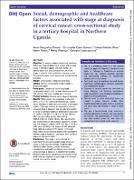| dc.contributor.author | Mwaka, Amos Deogratius | |
| dc.contributor.author | Garimoi, Orach Christopher | |
| dc.contributor.author | Were, Maloba Edward | |
| dc.contributor.author | Roland, Martin | |
| dc.contributor.author | Wabinga, Henry | |
| dc.contributor.author | Lyratzopoulos, Georgios | |
| dc.date.accessioned | 2021-04-28T12:54:53Z | |
| dc.date.available | 2021-04-28T12:54:53Z | |
| dc.date.issued | 2015-11-23 | |
| dc.identifier.citation | Mwaka, A.D., Garimoi, C.O., Were, E.M., Roland, M., Wabinga, H. and Lyratzopoulos, G., 2016. Social, demographic and healthcare factors associated with stage at diagnosis of cervical cancer: cross-sectional study in a tertiary hospital in Northern Uganda. BMJ open, 6(1), p.e007690. | en_US |
| dc.identifier.issn | 2044-6055 | |
| dc.identifier.uri | http://hdl.handle.net/20.500.12280/2773 | |
| dc.description.abstract | Objective To examine patient and primary healthcare factors and stage at diagnosis in women with cervical cancer in Northern Uganda with the intention to identify factors that are associated with advanced stages in order to inform policies to improve survival from cervical cancer in low income and middle income countries.
Design Cross-sectional hospital-based study.
Setting Tertiary, not-for-profit private hospital in postconflict region.
Participants Consecutive tissue-diagnosed symptomatic patients with cervical attending care. Of 166 patients, 149 were enrolled and analysed.
Primary outcome Cervical cancer stage at diagnosis.
Results Most women were diagnosed at stages III (45%) or IV (21%). After controlling for age, marital status, educational attainment and number of biological children, there was evidence for association between advanced stage at diagnosis and pre-referral diagnosis of cancer by primary healthcare professionals (adjusted OR (AOR)=13.04:95% CI 3.59 to 47.3), and financial difficulties precluding prompt help seeking (AOR=5.5:95% CI 1.58 to 20.64). After adjusting for age, marital status and educational attainment, women with 5–9 biological children (AOR=0.27:95% CI 0.08 to 0.96) were less likely to be diagnosed with advanced stage (defined as stages III/IV) cancer. In this pilot study, there was no statistical evidence for associations between stage at diagnosis, and factors such as age at diagnosis and marital status.
Conclusions This study is a first attempt to understand the descriptive epidemiology of cervical cancer in rural Ugandan settings. Understanding individual patient factors, patients’ behavioural characteristics and healthcare factors associated with advanced stage at diagnosis is essential for targeted effective public health interventions to promote prompt health seeking, diagnosis at early stage and improved survival from cervical cancer. | en_US |
| dc.language.iso | en | en_US |
| dc.publisher | BMJ Publishing Group Ltd | en_US |
| dc.relation.ispartofseries | BMJ open;6(1) | |
| dc.subject | Social | en_US |
| dc.subject | Demographic | en_US |
| dc.subject | Healthcare | en_US |
| dc.subject | Factors | en_US |
| dc.subject | Cervical cancer | en_US |
| dc.subject | Tertiary hospital | en_US |
| dc.subject | Northern Uganda | en_US |
| dc.title | Social, Demographic and Healthcare Factors Associated With Stage at Diagnosis of Cervical Cancer: Cross-Sectional Study in a Tertiary Hospital in Northern Uganda | en_US |
| dc.type | Article | en_US |


